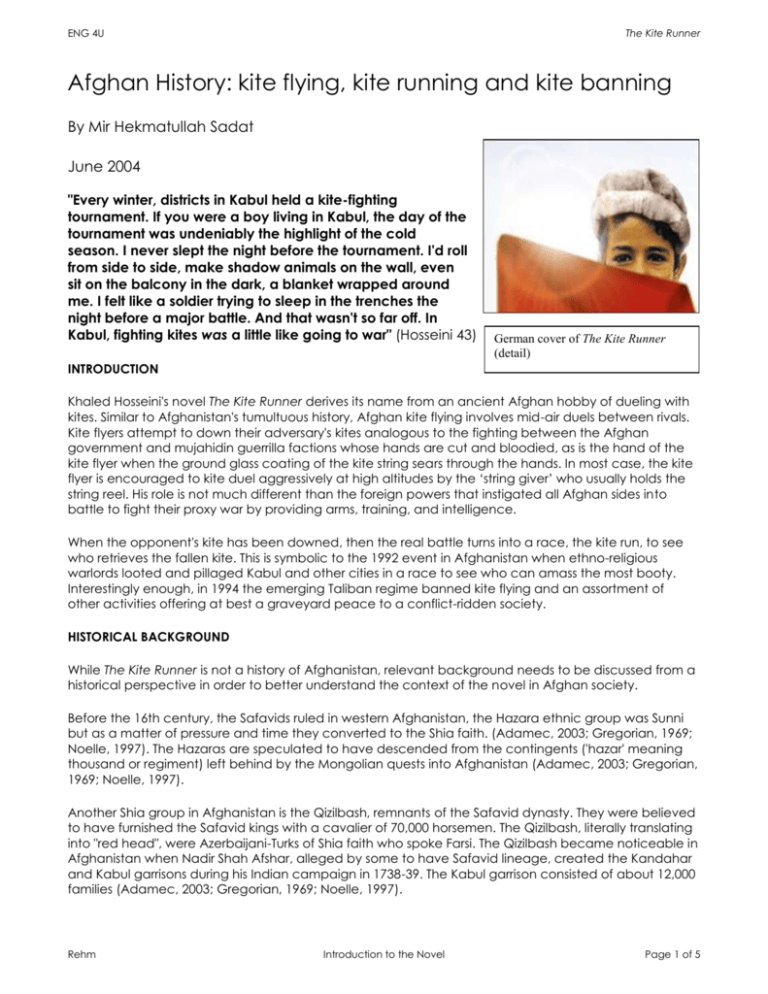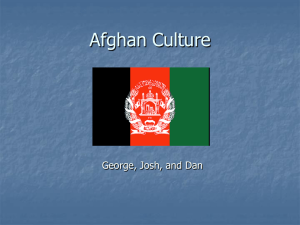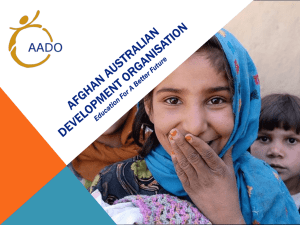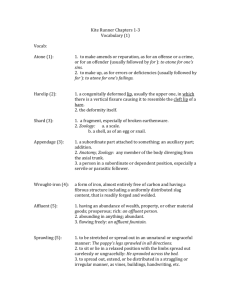ENG 4UThe Kite Runner Afghan History: kite flying, kite running and
advertisement

ENG 4U
The Kite Runner
Afghan History: kite flying, kite running and kite banning
By Mir Hekmatullah Sadat
June 2004
"Every winter, districts in Kabul held a kite-fighting
tournament. If you were a boy living in Kabul, the day of the
tournament was undeniably the highlight of the cold
season. I never slept the night before the tournament. I'd roll
from side to side, make shadow animals on the wall, even
sit on the balcony in the dark, a blanket wrapped around
me. I felt like a soldier trying to sleep in the trenches the
night before a major battle. And that wasn't so far off. In
Kabul, fighting kites was a little like going to war" (Hosseini 43)
German cover of The Kite Runner
(detail)
INTRODUCTION
Khaled Hosseini's novel The Kite Runner derives its name from an ancient Afghan hobby of dueling with
kites. Similar to Afghanistan's tumultuous history, Afghan kite flying involves mid-air duels between rivals.
Kite flyers attempt to down their adversary's kites analogous to the fighting between the Afghan
government and mujahidin guerrilla factions whose hands are cut and bloodied, as is the hand of the
kite flyer when the ground glass coating of the kite string sears through the hands. In most case, the kite
flyer is encouraged to kite duel aggressively at high altitudes by the ‘string giver’ who usually holds the
string reel. His role is not much different than the foreign powers that instigated all Afghan sides into
battle to fight their proxy war by providing arms, training, and intelligence.
When the opponent's kite has been downed, then the real battle turns into a race, the kite run, to see
who retrieves the fallen kite. This is symbolic to the 1992 event in Afghanistan when ethno-religious
warlords looted and pillaged Kabul and other cities in a race to see who can amass the most booty.
Interestingly enough, in 1994 the emerging Taliban regime banned kite flying and an assortment of
other activities offering at best a graveyard peace to a conflict-ridden society.
HISTORICAL BACKGROUND
While The Kite Runner is not a history of Afghanistan, relevant background needs to be discussed from a
historical perspective in order to better understand the context of the novel in Afghan society.
Before the 16th century, the Safavids ruled in western Afghanistan, the Hazara ethnic group was Sunni
but as a matter of pressure and time they converted to the Shia faith. (Adamec, 2003; Gregorian, 1969;
Noelle, 1997). The Hazaras are speculated to have descended from the contingents ('hazar' meaning
thousand or regiment) left behind by the Mongolian quests into Afghanistan (Adamec, 2003; Gregorian,
1969; Noelle, 1997).
Another Shia group in Afghanistan is the Qizilbash, remnants of the Safavid dynasty. They were believed
to have furnished the Safavid kings with a cavalier of 70,000 horsemen. The Qizilbash, literally translating
into "red head", were Azerbaijani-Turks of Shia faith who spoke Farsi. The Qizilbash became noticeable in
Afghanistan when Nadir Shah Afshar, alleged by some to have Safavid lineage, created the Kandahar
and Kabul garrisons during his Indian campaign in 1738-39. The Kabul garrison consisted of about 12,000
families (Adamec, 2003; Gregorian, 1969; Noelle, 1997).
Rehm
Introduction to the Novel
Page 1 of 5
ENG 4U
The Kite Runner
When the Afshari king, Nadir Shah Afshar, was assassinated, his general Ahmad Shah Durrani, a Sadozai
nobleman, became Afghanistan's first formal king in 1747. Ahmad Shah Durrani continued to hold the
Qizilbash as advisors and ghulam khana (royal personal bodyguards). Ahmad Shah Durrani's rearguard
army commander known as Wali Mohammad Khan Jawansher was given one of the settlements in
Kabul, the Chindawal District. When Ahmad Shah Durrani's son, Timur Shah, moved the capital from
Kandahar to Kabul, he brought with him more Qizilbash families to Chindawal (Adamec, 2003; Ghobar,
1967; Gregorian, 1969; Noelle, 1997). Overall, the Qizilbash continued to serve in high administrative and
army positions in successive administrations.
Not the same could be said of the Hazaras. However, practically all-immediate descendants of Ahmad
Shah Durrani left the Hazaras in relative peace with the exception of Shah Kamran's 1847 attack on
Hazarajat. Then, in the mid-1800s a distant cousin of Barakzai clan took power under Amir Dost
Mohammad, born to a Qizilbash wife of Sardar Payanda, was not sympathetic to the Shias and
exploited Sunni-Shia differences. Amir Dost Mohammad aligned the Sunnis and Qizilbash to the
detriment of the Hazaras. This alliance served for his conquest of the Hazarajat after which Amir Dost
Mohammad declared himself 'Amir-al-Mumineen' (Leader of the Faithful) attempting to compare
himself to the Prophet's cousin, Caliph Ali (Adamec, 2003; Gregorian, 1969; Noelle, 1997). In recent
times, the Taliban referred to their leader, Mullah Omar, similarly evoking memories of Amir Dost
Mohammad's conquest.
In 1891 Amir Dost Mohammad's grandson, Amir Abdur Rahman continued the policy of offering Sunnis
and tribesmen the title of 'ghazi' (infidel killer) for his conquest of Hazarajat. The result was the
destruction of the Hazara tribal system, annexation of Hazara personal property and land, and the
enslavement Hazaras to be sold in the Kabul bazaar. What ensued was the massive migration of
Hazaras to Quetta and Mashad, currently in Pakistan and Iran, respectively.
Amir Abdur Rahman's son, Amir Habibullah (r. 1901 - 1919) had Hazara 'kaniz' (concubines) in addition to
'ghulam-bacha' (royal slaves who were sons of influential people). Other high-ranking families also had
'kaniz' and 'ghulam' (male slave). However, he decreed that slavery should be outlawed but those
already enslaved could not break from the economic bondage or find enforcement of the anti-slave
decree. After his son, Shah Amanullah (r. 1919 - 1929) became king he outlawed slavery, discrimination,
returned seized land and property returned seized land and property emancipating Hazaras and other
Shias (Adamec, 2003; Gregorian, 1969; Noelle, 1997).
While Shah Amanullah outlawed slavery, still after his 1929 departure from Afghanistan until the early
1970s era when The Kite Runner's young Amir grows up in Kabul, the slave-like old practices of Hazaras
still continued. While some had broken from this bondage, they were not treated much better earning
low pay as servants ('nokahr' or 'muzdur') laboring as attendants, cooks, housekeepers, drivers,
midwives, cloth washers, and yard workers in many middle-class to high-ranking households.
In Afghanistan, socioeconomic status was highly correlated with ethnicity stratifying the greater Afghan
society. Income inequality was vast as most of the upper class came from the royal tribal clan, while the
lower class was comprised of the likes of Hassan's family of The Kite Runner.
Through symbolic structure, Hosseini deals with the inequalities and injustices. The book's political
dimension reveals that Hazaras and Shias could never move up the hierarchy unless they denied their
identity or became wealthy. It was not just the Shias and Hazaras but also the Kuchis, Uzbeks, Turkmen,
and 'atrafiyan or deehatiyan' (rural dwellers) no matter if they were Pashtu-speaking, Panjshiris, or
Badakhshis.
It was in reaction to these injustices that many of the likes of Amir and Hassan assisted in overthrowing
the feudal regime that facilitated or carelessly observed these injustices. Afghans clunk to the ideologies
of the Marxist left or Islamic right, which based on ideology and not on wealth or race gave them the
promise of equal status in a utopian society.
Rehm
Introduction to the Novel
Page 2 of 5
ENG 4U
The Kite Runner
Many attribute the late 1970s coming to power of rural natives as a reaction to decades of
discrimination of the center against the peripheral Pashto-speakers. In addition, the events of the 1890s
prevented the emergence of social or political organization among the Hazaras up until 1980 when a
member of the Hazara community finally became prime minister.
SOCIOPOLITICAL THEMES
While the author, Khaled Hosseini, is aware of Dr. Akram Osman’s writings, he professes that he has not
read recent Afghan short stories or novels, published mostly in Afghanistan or by exiled Afghan writers.
While this is a particularly remorseful event because it represents a literary discontinuity in the evolution
of Afghanistan's literature; from a different perspective, Hosseini's success marks a crucial moment for
Afghan immigrants in America as he moved past a barrier for immigrant writers wanting to plant their
cultural flag on the rocky, steep American literary landscape. The Kite Runner is the first novel written in
English by an Afghan in America creating space for emerging novelists of the Afghan Diaspora wanting
to contribute to American literature. Those interested can read the book in at least one of twelve
languages or wait to see the film version by the Hollywood production company DreamWorks who has
recently optioned the novel.
Written in the backdrop of 9/11 by an Afghan-born medical doctor, The Kite Runner presents a glimpse
of sociopolitical climate in Afghanistan and the Afghan community in northern California. The Kite
Runner achieves this by offering a fictional portrait of recent events manipulated by tribalism and
religious conservatism and aggravated by foreign interferences but overcome through the humanism
and bravery, which is fueled by the sense of community.
While the novel is an easy read, the themes require plenty of attention and willingness to tackle
multidimensional problems. The book can be read as a three-part novel. In the first part, Hosseini
engages in nostalgic childhood recreation of a lost Afghanistan during the last days of the monarchy of
Zahir Shah and the regime that overthrew him. The second part explores emigration during the Soviet
occupation of Afghanistan and the tragedies of a displaced and tired people living in cultural bubbles
of the past; it describes the process of migration and character of the expatriate community. The last
part explores the Taliban's Afghanistan. It deals with the horror humans can inflict on other humans and
stresses the underlying tone of standing up to repression.
Throughout each page of this compelling novel, readers have to remind themselves that Hosseini is
telling a story he has conjured up, the outcome of his life's adventures and creative imagination. As a
distinct trademark, Hosseini weaves Farsi, Dari and Pashtu dialectical phrases along with Afghan history,
cultural traditions, humor and social criticism into his debut book. Hosseini confronts many prejudgments
indoctrinated in some Afghans groups and families. As a microcosm of Afghan society, he tells the
fictional tale of people growing up under the same roof but treated tremendously differently.
The novel is told through the character of Amir as he seeks redemption for his betrayal of his friend
Hassan. The story is about two friends who symbolize opposite ends of a sociopolitical hierarchy. Amir is
Pashtun, Sunni, wealthy, and literate; whereas his servant's son, Hassan, is Hazara, Shia, poor, and
illiterate. They both have lost their mothers and shared the same wet nurse. Following their growth to
adulthood, the reader is drawn to with both characters and their dichotomous personalities.
The deformed Hassan and his father are mocked in public, and ironically Amir wishes he could trade
families for a moment of compassion that Hassan receives from his father. Uniquely, Amir's father also
wished Amir was not his only son because in Hassan he sees all the character attributes, which he
wished Amir possessed. Nonetheless, Amir realizes that in the long run he is better off because he is
Pashtun and not a Hazara in such a discriminating society.
Historically, the Hazaras were the most oppressed ethnicity in Afghanistan. Ironically, today the Pashtuns
who were historical ruling community and largest ethnic group, undergo 'reverse discrimination' and
Rehm
Introduction to the Novel
Page 3 of 5
ENG 4U
The Kite Runner
'guilty by ethnicity' bearing the brunt of Taliban atrocities. The Taliban were Pashtun-based but not all
Pashtuns supported the Taliban ideology as evident in The Kite Runner characters of Baba, Rahim Khan
and Amir who were diametrically opposed to religious bigots whether the Taliban or mujahidin guerrilla
factions.
In addition to Pashtuns and Hazaras, Afghanistan is comprised of other ethnicities such as the Tajiks,
Uzbeks, and Turkmen. During the last decade ethnic and religious warlords dominating each ethnic
group committed great atrocities against each other like the glass coating kite string cutting other
strings. This period is disdained as a bloody proxy war, symbolically fueled by what can be described as
foreign kite flyers, seared and fragmented Afghanistan despite its many cross-ethnic ties; for example,
Sunni Hazaras living near the Panjshir Valley, Pashtu-speaking Shias in Kandahar, Dari-speaking Pashtuns
in Kabul, and Pashtu-speaking Tajiks in Wardak.
Throughout the novel, the reader is exposed to many characters. Hosseini creates some heroic
characters such as Amir's father, Baba, the bear wrestling, honest, and respected Pashtun who distrusts
the mullahs (clerics); while Rahim Khan a progressive, social conscious friend of Baba dances in the
streets celebrating the false hope for peace in the Taliban takeover of Kabul ending the ethnic warfare
of the mujahidin guerillas factions. However, the Taliban regime's draconian edicts on women,
education, and even kite flying force Rahim Khan to flee for Pakistan.
In addition, the antagonist Amir overcomes his fear, pride, and his father generation's hypocrisy to right
the wrong, while Hassan represents their lost innocence. Hosseini balances these characters with some
demonic characters such as Asif, a bully who evolves into an unbelievably brutal Taliban official. In
hindsight, Hosseini wished he had added more humanity to Asif because he is too terrible to be
considered human at all. By the same token, Afghan history is not that simple but a complex jigsaw of
interrelated equations.
Sometimes ethnic and linguistic ties outweigh every other variable, and then at other times regional ties
prove to be stronger than ethnic ties. Among Afghans in the Western Diaspora, discussing the dilemmas
of divisive norms has become a taboo. When such topics are addressed all meaning is lost in falsified
statements and words. There is also an attempt by some to silence topic in order to prevent discussion
of ideologies or groups who wittingly brought desolation. Hence, denying the fact that there was ever
such a design in Afghanistan when in fact most societies underwent such obstacles.
In contrast, Hosseini's approach is not discreet as The Kite Runner slices through skin and flesh to expose
the socio-political and economic skeleton, which has beleaguered a nation-state formation in
Afghanistan. Those acquaint with Afghan history know group conflict has existed since Afghanistan's
inauguration in 1747.
CONCLUSION
Regrettably, the dreaded devil's spiral between victim and victimizer resulted in various factions
committing terrible atrocities under the name of ethnicity and religion in Afghanistan. Partly to be
blamed are ancient tribal traditions like "badal" (blood vengeance), use of religion for personal gains,
and ethnocentrism evident in Afghan history (as discussed earlier) which have prevented the
establishment of a compassionate regime. Like Amir, some Afghans not involved stood by watching,
either helplessly or indifferently, or fled Afghanistan.
Many have tried telling the story of Afghanistan but usually flinging a burqa (veil) over her true face.
Hosseini has cast that burqa off and describes in detail every wrinkle and birthmark. A famous Afghan
proverb says, "If you do not like the image in the mirror do not break the mirror but break your face."
It is up to Afghans to decide whether they wish to break their face and disintegrate Afghanistan or
accept it as their own self-reflection given its many flaws. Indeed, the image reflected is one of loyalty
Rehm
Introduction to the Novel
Page 4 of 5
ENG 4U
The Kite Runner
and betrayal as much as it is about redemption and ignorance. Nonetheless, Afghans must know that
no amount of superficial doctoring at the skin-level will resolve the deep-rooted issues beneath the
surface. Hosseini wrote in an email:
"The romanticized Afghanistan that lives in the minds of our parents (and in my own childhood memory)
probably never existed. That society had warts and pimples that no one talked about and that
strangely, no one talks about to this day. But I am glad that this book is reaching so many people. I get
e-mails from readers thanking me for finally putting a human face to the Afghans. I don't know if I've
done that, but it is true that our people have been -- in fiction at least -- faceless and voiceless for far
too long."
For many who were born or raised in exile, this face presents itself as an opportunity to live memories,
the happy as well as the sad, considering the Afghan Diaspora's loss of touch with Afghanistan. This
trend can only be described as time warped "bubble communities" who live for the nostalgia of their
era of success in Afghanistan.
In showing the unveiled face of Afghanistan, Hosseini, indirectly, criticizes the pre-war era which some
proudly claimed "an era where no one's nose was broken" as being nothing but a superficial façade.
The deceptive lure of Afghanistan's peacetime bears the roots of conflict. Many keep themselves,
consciously or unconsciously, oblivious to the cruel institutional, social, and political repression.
Individuals who only exercised their rights to speak and write and had not committed any crimes spent
years in the prison cells where they were subjected to all methods of torture. Imprisonments and killings
of common people and innocent intellectuals were still order of the day. The transition from peace to
war is never easy or one-sided, for this purpose the surface issues touched upon by Hosseini's
contribution comes from an underrepresented side of a complex episode. Most notably since this novel
would most likely never been allowed by the government to be printed during peacetime Afghanistan.
Afghans are notorious for falsifying preferences by publicly lying and privately being truthful about their
persuasions based on sectarianism, religious and political bigotry. Like a medical doctor, Khaled Hosseini
starts this sometimes excruciating healing process by opening the debate into the most pressing social
diseases plaguing Afghans: ethnic-religious relations, the dichotomy of the privileged and unprivileged,
the double standard for men and women, and the hypocrisy of those hiding their sins under the cloak of
religious righteousness.
Hosseini's writing challenges those still living in the tribal mindset to gain courage and break away from
their ethnic and clan affiliations, like Amir atone for sins, and join in the national reconciliation. Silencing
the voices of the oppressed under the guise of a half-hearted "national unity" is the continuation of
oppression manifested like the bone-crushing whips of the Vice-Virtue Police of the Taliban. Wounds of
the whip, whether physical or social, do not heal if they are masked or unacknowledged. If we do not
remember the past, we cannot forgive the past and work towards the future.
Only when these points are addressed, will the recovery start and Afghanistan and her people
successfully head down the path of nation building and reconstruction. Afghanistan does not belong
solely to the Pashtuns, Tajiks, Hazaras, Uzbeks, Turkmen, Hindus, or Sikhs but to all of them as one
collective body of Afghans. The point in time each of these groups realizes this concept, they will
transcend their ethno-religious identities and affiliation for the greater national identity and loyalty to
Afghanistan.
Rehm
Introduction to the Novel
Page 5 of 5








